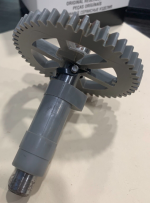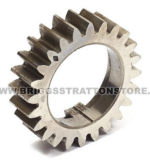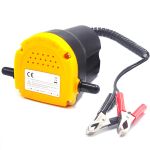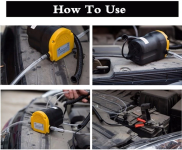You are using an out of date browser. It may not display this or other websites correctly.
You should upgrade or use an alternative browser.
You should upgrade or use an alternative browser.
Export thread
Model 128M05-0026-F1 with no compression.
#1
M
mikosh6
M
mikosh6
Our Toro mower with this engine started first pull after the winter. Ran fine for first lawn cut. Put mower on its side to clean under deck then as I usually do tried a restart. It wouldn't start so put away figuring probably just flooded. Got it out the other day and it wouldn't start. Pulled plug and it was wet with gas. Checked spark and that was good. After a few more tries I took off air cleaner and blocked the choke open and the engine fired up straight away. Ran perfectly for an hour of lawn mowing. Got it out the next day to finish and it wouldn't start. Blocked open choke and wouldn't start. Occasional loud bang out of the muffler as I pulled it over. Finally did a compression test and there was absolutely no compression. I pulled off the cylinder head suspecting a stuck valve but both are moving freely and I can rotate both valves with my fingers. They both seem to fully close. Is it possible that the valve timing is way off. I'm not familiar with the internals of this engine. Is it possible for that to happen very suddenly like this? Any other ideas?
#2

ILENGINE
ILENGINE
If you can rotate the valves with your finger pressure while the valve is fully closed then the valves are not sealing against the seat or the seat has come loose. Will require further disassembly to remove the valves and then grind the stems to reset the proper clearances.
#3
M
mikosh6
M
mikosh6
Thanks Ilengine. No I can only rotate the valves when they're up off the seat, gripping the valve edges with my fingers. I'm just really surprised that I can't see any movement on the compression tester needle. Same with putting my finger over the plug hole, can't feel any pressure at all. Even if valves were seating poorly or compression rings were damaged or worn I would still think there'd be a small amount of compression.
#4
O
Ocean909
O
Ocean909
Might need to spin the engine with a drill to deactivate the compression release to get a true reading. Is the head gasket good? Blown will cause loss of compression. Also if you whacked something recently the flywheel key may be slightly sheared causing a timing issue. If you are getting a loud bang out of the muffler I would guess you have at least some compression.
#5

Scrubcadet10
_________________________________________________________________________________________
It is possible that the valve timing could get thrown off as these engines use a plastic timing gear on the crankshaft (some metal) and camshaft gear, but i've worked on tons of these particular engines and have never seen one fail in that way, usually that happens if you strike a solid object with the blade.
You've verified the piston is moving in the cylinder, correct?
Scrubcadet10
even with the ACR, you should still get at least 55-60 PSI compression on these model 12 briggs.Might need to spin the engine with a drill to deactivate the compression release to get a true reading. Is the head gasket good? Blown will cause loss of compression. Also if you whacked something recently the flywheel key may be slightly sheared causing a timing issue. If you are getting a loud bang out of the muffler I would guess you have at least some compression.
_________________________________________________________________________________________
It is possible that the valve timing could get thrown off as these engines use a plastic timing gear on the crankshaft (some metal) and camshaft gear, but i've worked on tons of these particular engines and have never seen one fail in that way, usually that happens if you strike a solid object with the blade.
You've verified the piston is moving in the cylinder, correct?
#6
O
Ocean909
O
Ocean909
I stupidly bought a $13 (amazon) compression tester that wouldn't work on anything with an ACR unless it was spun with a drill. I figured if I did it someone else may have too.
#7
M
mikosh6
M
mikosh6
This engine is a flat head / side valve design. Does that type of Briggs & Stratton have compression release? I'm using the electric start to crank it over at a pretty good clip and not seeing compression. Is it possible for the compression release to fail and remain activated when the engine is turned over at higher speed? If so it could be the problem. The head gasket is good and yes the piston is moving.
#8

StarTech
StarTech
Yes the camshaft has an ACR.

Crankshaft gear is supposedly metal.

I would be checking the valve clearances as they do close up over time on L-head engines. When they have near zero clearance the engine loses most if not all it compression.
BTW most compression tester sold are for larger engine and not small engine like yours. Here I have Actron that is designed for small 23cc + engines. The compression check valve also must at the end of the hose at the cylinder end; otherwise the hose will expand and collaspe back to normal on every compression stroke throwing the readings.

Crankshaft gear is supposedly metal.

I would be checking the valve clearances as they do close up over time on L-head engines. When they have near zero clearance the engine loses most if not all it compression.
BTW most compression tester sold are for larger engine and not small engine like yours. Here I have Actron that is designed for small 23cc + engines. The compression check valve also must at the end of the hose at the cylinder end; otherwise the hose will expand and collaspe back to normal on every compression stroke throwing the readings.
#10
M
mikosh6
M
mikosh6
I will check the clearances. I'm not familiar with how ACR works physically. Does it rely on the shape of the camshaft lobe or is there some camshaft movement due to centrifugal force. I better do some research on that. Thanks everyone for the helpful suggestions.Yes the camshaft has an ACR.
View attachment 64499
Crankshaft gear is supposedly metal.
View attachment 64500
I would be checking the valve clearances as they do close up over time on L-head engines. When they have near zero clearance the engine loses most if not all it compression.
BTW most compression tester sold are for larger engine and not small engine like yours. Here I have Actron that is designed for small 23cc + engines. The compression check valve also must at the end of the hose at the cylinder end; otherwise the hose will expand and collaspe back to normal on every compression stroke throwing the readings.
#11
M
mikosh6
M
mikosh6
OK so I blame not spotting a slightly opened exhaust valve on my 77 yr old eyesight. Need cataract surgery. I measured the clearances and the intake was .007, the exhaust a whopping .030 Yes it was stuck open a bit. I have it freed up now using carb cleaner. Any suggestions for anything else to spray on the valve stem to help prevent it doing this trick again?
#12
T
Timdawg
T
Timdawg
Did you squirt some oil in cyl. To see if it improved? Starter fluid help to start?Thanks Ilengine. No I can only rotate the valves when they're up off the seat, gripping the valve edges with my fingers. I'm just really surprised that I can't see any movement on the compression tester needle. Same with putting my finger over the plug hole, can't feel any pressure at all. Even if valves were seating poorly or compression rings were damaged or worn I would still think there'd be a small amount of compression.
#13
K
kjonxx
K
kjonxx
If you have the head off, start at top dead center with piston making sure flywheel magnets are at coil for fire and rotate in direction of run and see if valves are opening and closing when they should, tells you if cam is bad or plastic slipped on camshaft.
#14
M
mikosh6
M
mikosh6
Problem solved. Freed up sticking exhaust valve by spraying stem with carb cleaner then gently tapping valve head with hammer and wooden dowel to seat it properly. Put back together and it's running fine. I'm just wondering if an additive like Sea Foam can help prevent exhaust valve sticking? And a big thank you to everyone for their advice. Appreciate it.
#15
K
kjonxx
K
kjonxx
Remove the valve and chuck the end in drill and use emery paper to polish.Problem solved. Freed up sticking exhaust valve by spraying stem with carb cleaner then gently tapping valve head with hammer and wooden dowel to seat it properly. Put back together and it's running fine. I'm just wondering if an additive like Sea Foam can help prevent exhaust valve sticking? And a big thank you to everyone for their advice. Appreciate it.
#16
H
henerythe8th
I've had amazing success with Seafoam in gas when experiencing carb issues.
H
henerythe8th
I would try seafoam in the gas and maybe some in the oil, if it's OK to put in the oil.Problem solved. Freed up sticking exhaust valve by spraying stem with carb cleaner then gently tapping valve head with hammer and wooden dowel to seat it properly. Put back together and it's running fine. I'm just wondering if an additive like Sea Foam can help prevent exhaust valve sticking? And a big thank you to everyone for their advice. Appreciate it.
I've had amazing success with Seafoam in gas when experiencing carb issues.
#17
T
tadawson
T
tadawson
Sounds like your tipping it over caused something to get into the valve guide/stem and cause it to bind.
#18
M
mikosh6
M
mikosh6
It may well have done but strange part was I eventually got it running by blocking open the choke and it ran great for an hour while I mowed the lawn. Didn't turn it on it's side after that and the next day it wouldn't start at all. Ripped into it and found the exhaust valve stuck open about 0.023". Lifter gap was just over 0.30" and spec is 0.007".Sounds like your tipping it over caused something tomget intomthe valve guide/stem and cause it to bind.
That's what I'm thinking I should have done. If it does stick again I'll definitely do that. Thanks for advice.Remove the valve and chuck the end in drill and use emery paper to polish.
#19
S
stoddardt02
S
stoddardt02
Problem solved. Freed up sticking exhaust valve by spraying stem with carb cleaner then gently tapping valve head with hammer and wooden dowel to seat it properly. Put back together and it's running fine. I'm just wondering if an additive like Sea Foam can help prevent exhaust valve sticking? And a big thank you to everyone for their advice. Appreciate it. I’m my
i just wanted to thank you for replying that it was fixed and what caused it. So many times people hop on, ask for advice and you never know if the problem was resolved. ThanksProblem solved. Freed up sticking exhaust valve by spraying stem with carb cleaner then gently tapping valve head with hammer and wooden dowel to seat it properly. Put back together and it's running fine. I'm just wondering if an additive like Sea Foam can help prevent exhaust valve sticking? And a big thank you to everyone for their advice. Appreciate it.
#20
J
jdtm

J
jdtm
Ignition timing may be an issue with running, but it does not affect compression. Maybe it is a long shot, but here is what I found when I had a 120000 series engine that would not start and had virtually no compression. The picture shows things exactly as they were when the head was removed.Might need to spin the engine with a drill to deactivate the compression release to get a true reading. Is the head gasket good? Blown will cause loss of compression. Also if you whacked something recently the flywheel key may be slightly sheared causing a timing issue. If you are getting a loud bang out of the muffler I would guess you have at least some compression.
Attachments
#21

flyhalhl@gmail.co.
flyhalhl@gmail.co.
Check the valve lift. Should be around 3Our Toro mower with this engine started first pull after the winter. Ran fine for first lawn cut. Put mower on its side to clean under deck then as I usually do tried a restart. It wouldn't start so put away figuring probably just flooded. Got it out the other day and it wouldn't start. Pulled plug and it was wet with gas. Checked spark and that was good. After a few more tries I took off air cleaner and blocked the choke open and the engine fired up straight away. Ran perfectly for an hour of lawn mowing. Got it out the next day to finish and it wouldn't start. Blocked open choke and wouldn't start. Occasional loud bang out of the muffler as I pulled it over. Finally did a compression test and there was absolutely no compression. I pulled off the cylinder head suspecting a stuck valve but both are moving freely and I can rotate both valves with my fingers. They both seem to fully close. Is it possible that the valve timing is way off. I'm not familiar with the internals of this engine. Is it possible for that to happen very suddenly like this? Any other ideas?
They should be removed and a proper size reamer used on valve guides. Guides build up deposits so diameter shrinks and valves then sieze. Even 7 thousanths is slightly high. Flat heads have larger clearance than the newer overhead types.OK so I blame not spotting a slightly opened exhaust valve on my 77 yr old eyesight. Need cataract surgery. I measured the clearances and the intake was .007, the exhaust a whopping .030 Yes it was stuck open a bit. I have it freed up now using carb cleaner. Any suggestions for anything else to spray on the valve stem to help prevent it doing this trick again?
#22

StarTech
As for the valve guides the deposits are usually on the valve stems and not the guides. The exhaust valve does have a replaceable valve guide. What can happen because of stems sticking in the guides is the valve guides can move.
Now the OP should need the 1/4 valve repair tool set to the do this replacement and reaming; although, these Sintered guides seldom need reaming.
StarTech
Valve clearance on this engine areThey should be removed and a proper size reamer used on valve guides. Guides build up deposits so diameter shrinks and valves then sieze. Even 7 thousanths is slightly high. Flat heads have larger clearance than the newer overhead types.
| Intake Valve | .005-.007 in (.13-.18 mm) |
| Exhaust Valve | .007-.009 in (.18-.23 mm) |
As for the valve guides the deposits are usually on the valve stems and not the guides. The exhaust valve does have a replaceable valve guide. What can happen because of stems sticking in the guides is the valve guides can move.
Now the OP should need the 1/4 valve repair tool set to the do this replacement and reaming; although, these Sintered guides seldom need reaming.
#23
M
mikosh6
M
mikosh6
Thought I would add a final post about my mower issue. After leaving the mower for a week it wouldn't start again after freeing the exhaust valve with choke cleaner. I removed the plug and the exhaust valve is visible. I rotated the crank to the point where the vavlve should be closed and gently tapped the valve down on its seat with a piece of wooden dowel. Tried starting and the engine fired up right away. I purchased some Seafoam, took out the plug, rotated the crank shaft until the exhaust valve opened fully, then sprayed a Seafoam behind the valve where it would land on the stem. Rotated crank and tapped the valve down with the dowel; repeated this about 4 times. Replaced the plug and left the mower for a week before firing it up. It's now been starting and running fine for over a month so I'm happy with that. If it does have the issue again down the road this will be the first thing I try. Hope this will help someone else down the road.
#25
S
slomo
Fix the valve and guide clearance issue. Polish the valve stem and clean up the tappet end if needed. Use some gun bore brushes and solvent to free up the guide. Most likely tipping the mower cause oil to get where it doesn't belong. Another reason to get a hand or electric powered oil evac pump. Stop tipping mowers over. Many don't know what side to tip and if tipped are super hard to start. Get with the times.


S
slomo
Seafoam is nothing but a solvent. Which when placed in the oil, just thins the viscosity way down. Depending on how much was used could be worse. Hot running air cooled engines. See where this is going? So your SAE 30W oil just became an SAE 20 or less.I would try seafoam in the gas and maybe some in the oil, if it's OK to put in the oil.
I've had amazing success with Seafoam in gas when experiencing carb issues.
Fix the valve and guide clearance issue. Polish the valve stem and clean up the tappet end if needed. Use some gun bore brushes and solvent to free up the guide. Most likely tipping the mower cause oil to get where it doesn't belong. Another reason to get a hand or electric powered oil evac pump. Stop tipping mowers over. Many don't know what side to tip and if tipped are super hard to start. Get with the times.


#26
M
mikosh6
M
mikosh6
If you read my post you'd see that the Seafoam went in behind the valve onto the stem ONLY to use it's solvent properties. Nothing added to the oil. Yes the motor shroud was taken off and all was clean, as you'll see in an earlier post I replaced the head gasket.
#27
S
slomo
S
slomo
I read that. Nothing added to the oil. I was just stating the obvious about seafoam snake oil.If you read my post you'd see that the Seafoam went in behind the valve onto the stem ONLY to use it's solvent properties. Nothing added to the oil. Yes the motor shroud was taken off and all was clean, as you'll see in an earlier post I replaced the head gasket.
